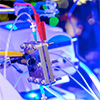Jun 28, 2023
(Nanowerk Information) New era evolved by way of Rice College engineers may just decrease the price of shooting carbon dioxide from all sorts of emissions, a possible game-changer for each industries taking a look to conform to evolving greenhouse gasoline requirements and for the emergent energy-transition financial system.In keeping with a find out about printed in Nature ("Steady carbon seize in an electrochemical solid-electrolyte reactor"), the gadget from the lab of chemical and biomolecular engineer Haotian Wang can immediately take away carbon dioxide from assets starting from flue gasoline to the ambience by way of the use of electrical energy to urge a water-and-oxygen-based electrochemical response. This technological feat may just flip direct air seize from fringe trade ⎯ there are best 18 vegetation recently in operation international ⎯ right into a promising entrance for local weather trade mitigation.
(Nanowerk Information) New era evolved by way of Rice College engineers may just decrease the price of shooting carbon dioxide from all sorts of emissions, a possible game-changer for each industries taking a look to conform to evolving greenhouse gasoline requirements and for the emergent energy-transition financial system.In keeping with a find out about printed in Nature ("Steady carbon seize in an electrochemical solid-electrolyte reactor"), the gadget from the lab of chemical and biomolecular engineer Haotian Wang can immediately take away carbon dioxide from assets starting from flue gasoline to the ambience by way of the use of electrical energy to urge a water-and-oxygen-based electrochemical response. This technological feat may just flip direct air seize from fringe trade ⎯ there are best 18 vegetation recently in operation international ⎯ right into a promising entrance for local weather trade mitigation.
[embed]https://www.youtube.com/watch?v=7sGoU91RcEE[/embed]
Maximum carbon-capture programs contain a two-step procedure: First, high-pH liquids are used to split the carbon dioxide, which is acidic, from mixed-gas streams comparable to flue gasoline. Subsequent, the carbon dioxide is regenerated from the answer thru heating or by way of injecting a low-pH liquid.“As soon as the carbon dioxide is trapped in those solvents, it's important to regenerate it,” Wang stated.“Conventional amine scrubbing strategies require temperatures of 100-200 levels Celsius (212-392 Fahrenheit). For calcium carbonate-based processes you want temperatures as excessive as 900 Celsius (1652 Fahrenheit).“There are actually no chemical compounds produced or ate up with our procedure. We additionally don’t wish to warmth up or pressurize our instrument, we simply wish to plug it into an influence outlet and it'll paintings.”Some other problem of present carbon-capture applied sciences is their reliance on large-scale, centralized infrastructure. In contrast, the gadget evolved within the Wang lab is a scalable, modular, point-of-use idea that may be tailored to a lot of situations.“The era can also be scaled as much as commercial settings ⎯ energy vegetation, chemical vegetation ⎯ however the beauty of it's that it permits for small-scale use as smartly: I will even use it in my place of business,” Wang stated. “Shall we, for instance, pull carbon dioxide from the ambience and steadily inject that concentrated gasoline right into a greenhouse to stimulate plant expansion. We’ve heard from house era firms keen on the use of the instrument on house stations to take away the carbon dioxide astronauts exhale.”The reactor evolved by way of Wang and his crew can steadily take away carbon dioxide from a simulated flue gasoline with potency above 98% the use of a fairly low electrical energy enter.“The electrical energy used to energy a 50-watt lightbulb for an hour will yield 10 to twenty-five liters of high-purity carbon dioxide,” stated Peng Zhu, a chemical and biomolecular engineering graduate scholar and lead writer at the find out about.Wang famous that the method has “no carbon footprint or an overly restricted footprint” if powered by way of electrical energy from renewable assets comparable to sun or wind.“That is nice information bearing in mind that renewable electrical energy is turning into increasingly cost-effective,” Wang stated.The reactor is composed of a cathode set as much as carry out oxygen aid, an oxygen evolution reaction-performing anode and a compact but porous solid-electrolyte layer that permits environment friendly ion conduction. An previous model of the reactor used to be used to cut back carbon dioxide into natural liquid fuels and scale back oxygen into natural hydrogen peroxide answers.“Prior to now, our crew targeted basically on carbon dioxide usage,” Zhu stated. “We labored on generating natural liquid merchandise like acetic acid, formic acid, and many others.”In keeping with Wang, Zhu noticed throughout the analysis procedure that gasoline bubbles flowed out of the reactor’s heart chamber along side the liquids.“At first, we didn’t pay numerous consideration to this phenomenon,” Wang stated. “Alternatively, Peng noticed that if we carried out extra present there have been extra bubbles. That’s an instantaneous correlation, which means that that one thing now not random is going on.”The researchers learned that the alkaline interface generated throughout aid reactions on the reactor’s cathode facet interacted with carbon dioxide molecules to shape carbonate ions . The carbonate ions migrate into the reactor’s solid-electrolyte layer the place they mix with protons as a result of water oxidation on the anode facet, forming a continuing drift of high-purity carbon dioxide.“We randomly found out this phenomenon throughout our earlier research,” Wang stated. “We then tuned and optimized the era for this new challenge and new utility. We’ve spent years of continuing paintings on this sort of electrochemical instrument.“Medical discovery steadily calls for this affected person, steady commentary and the interest to be informed what’s truly occurring, the selection to not forget the ones phenomena that don’t essentially have compatibility within the experimental body.”
[ad_2]






0 Comentários